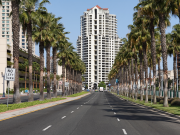Brief Overview of Real Estate Investment
Real estate investment is a strategy that involves purchasing, owning, managing, renting, or selling real property for profit. This sector has seen significant growth in the Philippines, thanks to the country’s steady economic progress, robust consumption, and growing population.
Investing in real estate can be lucrative, providing financial benefits such as cash flow, tax advantages, potential appreciation, and investment portfolio diversification. However, like any other investment, it comes with its own set of risks and challenges. Therefore, making informed decisions is crucial to achieving success in this field. Remember, whether you’re a seasoned investor or a first-time buyer, having the right information at your fingertips is key to success in the real estate market. And that’s precisely what HousingInteractive aims to provide.
Defining Commercial and Residential Real Estate
Regarding real estate investment, properties are typically categorized into two types:
Commercial Real Estate
These are properties used exclusively for business purposes. They include office buildings, shopping centers, warehouses, and industrial buildings. The commercial real estate market in the Philippines has been buoyed by the strong demand from the Business Process Outsourcing (BPO) sector and offshore gaming operators. Commercial real estate investments often involve higher purchase prices, complex contracts, and multi-year leases. However, they also offer the potential for greater returns on investment.
Residential Real Estate
Encompasses properties designed for people to live in, such as houses, apartments, condominiums, and townhouses. The residential real estate market in the Philippines is primarily driven by the increasing urbanization, the rise of the middle class, and overseas Filipino workers seeking to secure homes for their families. While the upfront costs of investing in residential real estate may be lower than commercial properties, the returns are typically more stable and predictable, making it a popular choice among first-time investors.
Understanding the differences between these two real estate types is the first step toward making an informed investment decision. Each offers unique opportunities and challenges, and the choice between the two will largely depend on an investor’s financial goals, risk tolerance, and investment horizon.
Earnings Potential: Commercial vs. Residential Real Estate
Higher Earning Potential in Commercial Real Estate
Explanation of Rental Yield
Rental yield is a key metric in real estate investment, representing the annual return on investment from renting out a property, expressed as a percentage of the property’s cost or market value. It’s a crucial factor for investors as it helps evaluate an investment property’s potential income and profitability.
Comparison of Rental Yields in Commercial and Residential Properties
Commercial properties in the Philippines offer higher rental yields than residential ones. Specifically, the average gross rental yield for office spaces remained steady at 6.90% in Q3 2023.
On the other hand, residential properties in Manila have an average rental yield of around 5.16%. This higher yield in commercial real estate can be attributed to factors such as longer lease terms and higher rent rates, making them an attractive option for investors seeking high returns.
Gross Revenue Returns in Residential Real Estate
Factors Contributing to Better Returns in Residential Areas
While commercial properties may offer higher rental yields, residential real estate should not be overlooked, certain factors can contribute to better returns in residential areas. For instance, the residential real estate market in the Philippines is driven by increasing urbanization, the rise of the middle class, and overseas Filipino workers investing in homes for their families. These factors lead to strong demand and potentially higher rental rates, contributing to attractive returns. Furthermore, residential properties often have shorter lease terms, allowing for frequent rent adjustments in line with market trends.
Risks and Stability in Real Estate Investment
Risk Factors in Commercial Real Estate
The Role of Units and Tenants in Risk Assessment
Investing in commercial real estate in the Philippines involves several risk factors. A significant one is the reliance on a single or small number of tenants. If a tenant vacates, the property can sit empty until a new tenant is found, causing a loss of income. Additionally, commercial leases are often longer, so if a tenant becomes problematic, resolving issues can be a lengthy process.
Stability Factors in Residential Real Estate
Exploring the Larger Pool of Potential Tenants
On the other hand, residential real estate offers more stability. In the Philippines, a larger pool of potential tenants for residential properties can lead to shorter vacancies. This is especially true in urban areas with high demand for housing. Furthermore, residential leases are typically shorter, allowing for regular adjustments to rental rates to reflect current market conditions. This flexibility can contribute to a steady, reliable cash flow, making residential real estate a stable investment option.
Appreciation and Cash Flow: A Comparative Analysis
Understanding Appreciation in Real Estate
Appreciation refers to the increase in a property’s value over time, influenced by factors such as market conditions, inflation, and improvements made to the property. In the Philippines, several elements can drive appreciation, including supply and demand dynamics, property location, and future development plans in an area.
Comparison of Appreciation Rates in Commercial and Residential Properties
While specific rates can vary, historical data suggests that commercial and residential real estate in the Philippines have shown significant appreciation. For instance, a study from 1031crowdfunding indicates that commercial properties often demonstrate robust appreciation, driven by factors like strategic location and potential for rental income growth. Similarly, residential properties can be appreciated due to urbanization, increased demand, and infrastructural developments.
Insights into Cash Flow Considerations in Both Types of Investments
Cash flow is also a critical aspect of real estate investing. It refers to the net income generated from the property after accounting for all expenses. Cash flow can be more predictable and higher for commercial properties due to longer lease terms and escalation clauses often included in commercial leases. Meanwhile, residential properties may offer a steady but typically lower cash flow. However, they can often benefit from a broader pool of potential tenants, leading to lower vacancy rates.
Tenant Demographics and Lease Terms
Differences in Tenant Demographics between Commercial and Residential Real Estate
Tenant demographics vary significantly between commercial and residential real estate. For commercial properties in the Philippines, tenants often include businesses, corporations, and sometimes government entities. These tenants typically seek strategic locations that offer high visibility, accessibility, and proximity to their target market.
On the other hand, residential real estate tenants are individuals or families looking for a place to live. Factors such as proximity to schools, hospitals, shopping centers, and workplaces play a crucial role in their choice of residence. Therefore, residential properties tend to attract a broader demographic range, including students, young professionals, families, and retirees.
Discussion on Lease Terms in Commercial and Residential Sectors
Lease terms also differ in commercial and residential real estate. Commercial leases are often longer, ranging from 5 to 10 years or more, providing a stable, long-term cash flow for the property owner. These leases may also include escalation clauses, allowing for periodic increases in rental rates.
Residential leases in the Philippines are typically shorter, often one year, and may be subject to rent control laws, which can limit the amount landlords can increase rent annually. Despite shorter lease terms, residential properties can provide a steady income stream due to their high demand and the continuous need for housing.
Conclusion
Throughout this analysis, we delved into the nuances of commercial and residential real estate in the Philippines. We explored the concept of appreciation and how it affects property values, highlighting the factors that drive appreciation in both sectors. We also examined cash flow considerations, revealing that while commercial properties may offer higher and more predictable cash flows, residential properties provide a steady income stream with potentially lower vacancy rates.
Furthermore, we considered tenant demographics and lease terms differences between the two sectors. Commercial tenants often consist of businesses and corporations seeking strategic locations, while residential tenants are individuals or families prioritizing proximity to essential amenities. Lease terms in the commercial sector tend to be longer, offering stable, long-term cash flows, whereas residential leases are typically shorter but benefit from high demand.
A Quick Comparison of Commercial and Residential Real Estate Investment in the Philippines
| Aspect | Commercial Real Estate | Residential Real Estate |
| Property Types | Office buildings, shopping centers, warehouses, industrial buildings | Houses, apartments, condominiums, townhouses |
| Market Drivers | Business Process Outsourcing (BPO) sector, offshore gaming operators | Urbanization, middle-class growth, overseas Filipino workers |
| Purchase Prices | Higher purchase prices | Potentially lower upfront costs |
| Lease Terms | Longer leases (5 to 10 years or more) | Shorter leases (often one year), subject to rent control laws |
| Rental Yields (Philippines) | Higher (average gross rental yield for office spaces: 6.90%) | Lower (average rental yield for residential properties in Manila: 5.16%) |
| Earnings Potential | Greater potential for higher returns on investment | More stable and predictable returns, potentially lower upfront costs |
| Risk Factors | Reliance on a small number of tenants, longer resolution process | Larger pool of potential tenants, shorter vacancies, regular rent adjustments |
| Appreciation Factors | Strategic location, possible for rental income growth | Urbanization, increased demand, infrastructural developments |
| Tenant Demographics | Businesses, corporations, government entities | Individuals, families, students, young professionals, retirees |
| Stability | Potential for stability, but risks associated with tenant vacancies | Generally more stable with a larger tenant pool and shorter vacancies |
| Cash Flow | Predictable and higher due to longer lease terms and escalation clauses | Steady but typically lower, benefits from a broader tenant pool and potentially lower vacancy rates |
| Investor Accessibility | Requires significant capital and expertise | More accessible for first-time investors |
Final Thoughts on Choosing Between Commercial and Residential Real Estate for Investment
Choosing between commercial and residential real estate ultimately depends on an investor’s financial goals, risk tolerance, and market understanding. Both sectors offer unique opportunities and challenges. Commercial real estate can provide substantial returns and stability but requires significant capital and expertise.
On the other hand, residential real estate can be more accessible for first-time investors, offering a steady income and a broader tenant pool, albeit with potentially lower returns.
Successful real estate investment requires thorough research, careful planning, and a clear understanding of market trends. Whether one opts for commercial or residential investment, the key is to make informed decisions that align with their investment strategy and financial objectives.

























